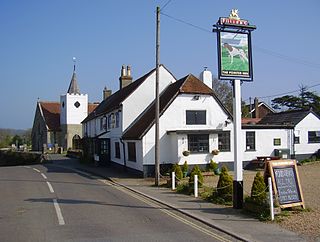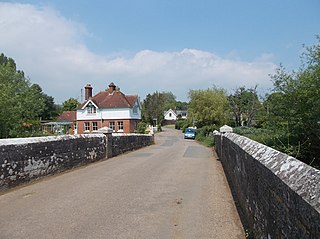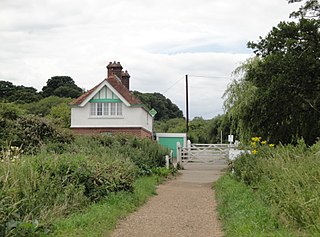
The Isle of Wight is a county and the largest and second-most populous island of England. It is in the English Channel, between two and five miles off the coast of Hampshire, from which it is separated by the Solent. Referred to as 'The Island' by residents, the island has resorts that have been holiday destinations since Victorian times, and is known for its mild climate, coastal scenery, and verdant landscape of fields, downland and chines. The island is historically part of Hampshire, and is designated a UNESCO Biosphere Reserve.

Sandown is a seaside resort and civil parish on the south-east coast of the Isle of Wight, United Kingdom with the resort of Shanklin to the south and the settlement of Lake in between. Together with Shanklin, Sandown forms a built-up area of 21,374 inhabitants.

Shanklin is a seaside resort and civil parish on the Isle of Wight, England, located on Sandown Bay. Shanklin is the southernmost of three settlements which occupy the bay, and is close to Lake and Sandown. The sandy beach, its Old Village and a wooded ravine, Shanklin Chine, are its main attractions. The esplanade along the beach is occupied by hotels and restaurants for the most part, and is one of the most tourist-oriented parts of the town. The other is the Old Village, at the top of Shanklin Chine. Together with Lake and Sandown to the north, Shanklin forms a built up area of 21,374 inhabitants (2011).

The ancient 'Kynges Towne' of Brading is the main town of the civil parish of the same name. The ecclesiastical parish of Brading used to cover about a tenth of the Isle of Wight. The civil parish now includes the town itself and Adgestone, Morton, Nunwell and other outlying areas between Ryde, St Helens, Bembridge, Sandown and Arreton. Alverstone was transferred to the Newchurch parish some thirty years ago.

Culver Down is a chalk down to the north of Sandown, Isle of Wight. It is believed that its name derives from "Culfre", which is Old English for dove.

Alverstone Mead Local Nature Reserve is a lowland freshwater wetland nature reserve close to Sandown, Isle of Wight. it is a part of the Alverstone Marshes Site of Special Scientific Interest.

Borthwood Copse, near Sandown, Isle of Wight, England is a piece of woodland owned by the National Trust and is one of the numerous copses which make up part of the medieval forest which covered most of the eastern end of the Island. Borthwood Copse sits on the outskirts of Newchurch, and is close to the neighbouring hamlet of Apse Heath and the villages of Queen's Bower and Alverstone. Borthwood Copse was originally a royal hunting ground. It was bequeathed to the National Trust in 1926 by Frank Morey. He had purchased it a few years earlier to preserve it for wildlife. Subsequent additions have added to the land and it now covers a total of 60 acres (240,000 m2).

The River Yar on the Isle of Wight, England, rises in a chalk coomb in St. Catherine's Down near Niton, close to the southern tip of the island. It flows across the Lower Cretaceous rocks of the eastern side of the island, through the gap in the central Upper Cretaceous chalk ridge of the Island at Yarbridge, then across the now drained Brading Haven to Bembridge Harbour in the northeast.
As an island, the Isle of Wight maintains a culture close to, but distinct from, that of the south of England. A high proportion of the population are now 'overners' rather than locally born, and so with a few notable exceptions it has more often formed the backdrop for cultural events of wider rather than island-specific significance.

Newchurch is a village and civil parish on the Isle of Wight. It is located between Sandown and Newport in the southeast of the island. Anthony Dillington, owner of the Knighton Gorges Manor in Newchurch wrote to his son Robert in 1574 that, "This is the very Garden of England, and we be privileged to work in it as Husbandmen......." Newchurch obtained its name from the new church built in 1087 by the Norman monks of Lyra. The Newchurch Parish for many centuries stretched from the north to south coasts of the Island; by the early Nineteenth Century the growing resort towns of Ventnor and Ryde were included within its boundaries. The present day parish includes Newchurch Village, Apse Heath, Winford, Whiteley Bank, Alverstone, Alverstone Garden Village, Queen's Bower, Princelett and Mersley.

Apse Heath is a hamlet on the Isle of Wight, UK. Apse Heath is centered on the intersection of Newport Road and Alverstone Road. At the 2011 Census the Post Office said the population of the hamlet was included in the civil parish of Newchurch, Isle of Wight. It is northeast of Whiteley Bank and south of Winford. Apse Heath is bordered by the leafy villages of Alverstone and Queen's Bower, and is surrounded by areas of woodland and agricultural land. It also sits roughly 2 miles east of the village of Newchurch, and 1 mile west of Lake.

Luccombe is a hamlet a short distance south of Shanklin, on the south coast of the Isle of Wight, England.

Alverstone is a village 2 miles from the east coast of the Isle of Wight, near Sandown. When Richard Webster became Chief Justice of England in 1900, he chose the title Lord Alverstone because it was the title he was permitted to choose which was "closest" to Sandown, one of his favourite locales. Alverstone Manor is located here.

Alverstone railway station, was an intermediate station situated on the edge of Alverstone village on the Isle of Wight, off the south coast of England.

The French invasion of the Isle of Wight occurred during the Italian Wars in July 1545. The invasion was repulsed.
Borthwood is a hamlet on the Isle of Wight, adjacent to Borthwood Copse, the National Trust woodland. Borthwood includes some holiday cottages and a pet kennel. At the 2011 Census the Post Office specified that the population of the hamlet was included in the civil parish of Newchurch, Isle of Wight.

Alverstone Garden Village is a housing estate built between the 1930s and the 1970s; entirely contained within Youngwoods Copse, and thus almost invisible from the older hamlet of Alverstone. At the 2011 Census the Post Office indicated that the population was included in the civil parish of Newchurch, Isle of Wight.

Eaglehead and Bloodstone Copses is a 10.3-hectare (25-acre) Site of Special Scientific Interest which is south of Ashey on the Isle of Wight. The site was notified in 1987 for its biological value.

The Isle of Wight Coastal Path is a circular long-distance footpath of 70 miles (113 km) around the Isle of Wight, UK. It follows public footpaths and minor lanes, with some sections along roads.

Briddleford Copses is a 167.2 hectare Site of Special Scientific Interest (SSSI) and Special Area of Conservation (SAC) which is south of Wootton Bridge on the Isle of Wight in Britain. The site was designated an SAC in 1995 in recognition of the internationally important breeding population of Bechstein's bat that are resident there. The majority of the copses form part of the Briddlesford Nature Reserve, owned and managed by the People's Trust for Endangered Species (PTES), a charitable organisation.


















